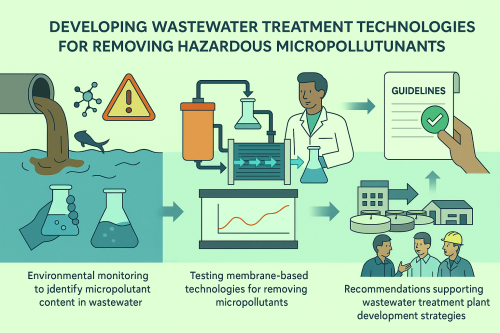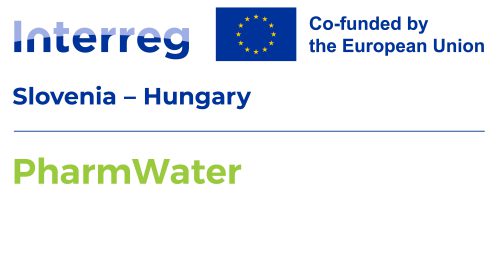Project overview
 In Europe, in the member states of the European Economic Area, urban wastewater collected in agglomerations equivalent to 10,000 inhabitants is mandatorily subjected to secondary treatment (Directive 91/271/EEC on urban wastewater treatment) before being discharged into natural waters. As a result, a significant portion of urban wastewater undergoes various treatment processes (physical, chemical, biological treatment, final settling) before reaching natural waters. In accordance with EU directives, the principle of “do not cause significant harm,” and the Zero Pollution Action Plan, the treatment of urban wastewater is prioritized by the EU in a manner that does not significantly alter the quality of the receiving water body. To achieve the goals of the EU Green Deal (COM/2019/640), such as pollution-free environments, preservation, and protection of biological diversity, and commitments to climate neutrality (e.g., “Fit for 55” package), a proposal to amend Directive 91/271/EEC on urban wastewater treatment was adopted on September 26, 2023. This proposal identifies pharmaceuticals and cosmetic residues as the main sources of micropollutants in urban wastewater that require further treatment (fourth stage). If the directive is amended, wastewater treatment plant reconstruction will be necessary, as currently, there are very few modern treatment plants applying the fourth stage.
In Europe, in the member states of the European Economic Area, urban wastewater collected in agglomerations equivalent to 10,000 inhabitants is mandatorily subjected to secondary treatment (Directive 91/271/EEC on urban wastewater treatment) before being discharged into natural waters. As a result, a significant portion of urban wastewater undergoes various treatment processes (physical, chemical, biological treatment, final settling) before reaching natural waters. In accordance with EU directives, the principle of “do not cause significant harm,” and the Zero Pollution Action Plan, the treatment of urban wastewater is prioritized by the EU in a manner that does not significantly alter the quality of the receiving water body. To achieve the goals of the EU Green Deal (COM/2019/640), such as pollution-free environments, preservation, and protection of biological diversity, and commitments to climate neutrality (e.g., “Fit for 55” package), a proposal to amend Directive 91/271/EEC on urban wastewater treatment was adopted on September 26, 2023. This proposal identifies pharmaceuticals and cosmetic residues as the main sources of micropollutants in urban wastewater that require further treatment (fourth stage). If the directive is amended, wastewater treatment plant reconstruction will be necessary, as currently, there are very few modern treatment plants applying the fourth stage.
The quality of the treated wastewater discharged into receiving water bodies is crucial for health and environmental protection, as stipulated by the Water Framework Directive (WFD) adopted by the European Commission. This holds true for small streams and watercourses within the Mura-Drava-Danube UNESCO Biosphere Reserve, supported by five countries, where potential pharmaceutical residues can impact the quality of these water bodies, affecting the area’s habitats and ecosystems. Despite receiving treated wastewater on both sides of the Slovenian-Hungarian border, these small watercourses have a low dilution ratio due to low water flow. Limited data is available on the micropollutant content of these watercourses (both in terms of quality and quantity indicators), but all of them directly or indirectly contribute to the Mura River, a significant ecotourism destination and a source of drinking water. Unlike the Mura River (Strahler number >3, Strahler, 1957), pharmaceutical residue levels in these smaller first and second-order watercourses with a lower Strahler number exhibit significant temporal variations.
The objective of this project is to analyze the quality and quantity of pharmaceutical residues in surface waters and treated wastewater, examine their spatial and temporal distribution, and explore removal possibilities from treated wastewater. The target area is the middle section of the Mura River, near the Slovenian-Hungarian border, encompassing smaller watercourses receiving treated wastewater and five wastewater treatment plants. Data collected through monthly sampling allows estimating the impact of pharmaceutical residues on habitats, while laboratory wastewater treatment experiments demonstrate a tangible, practical example of pollution mitigation.
As the main outcome of the project, a strategy (RCO83, RCR79) has been outlined for professionals, addressing key considerations for the integration of the fourth treatment stage during the technological reconstruction of wastewater treatment plants for pharmaceutical residue removal. Additionally, it includes a proposal for wastewater treatment technology, an environmental assessment methodology, and an evaluation of the environmental risks associated with discharged substances. Through Slovenian-Hungarian collaboration, the project’s results benefit professionals working towards pollution mitigation in the region, saving costs by assessing pollution in receiving water bodies based on risk and examining the efficiency of region-specific pharmaceutical pollutant removal through membrane technology combined with adsorption.
The ultimate goal of this project is to contribute in the long term to the elimination of pharmaceutical residues from small watercourses, thereby achieving the objectives of Priority 1 (PO2) and the goals of the EU Strategy for the Danube Region (PA4, 6, 10). This contributes to a toxin-free environment, protects biodiversity and Natura 2000 areas, ensures better quality conditions for smaller watercourses, enabling multifunctional water reuse, safeguarding human health, and protecting underground and drinking water sources from further pharmaceutical residue pollution.
Project achievements and materials
In this section you can find useful materials related to the project.
- File 1
- File 2
Project duration
Project start date:
1.12.2024
Project end date:

